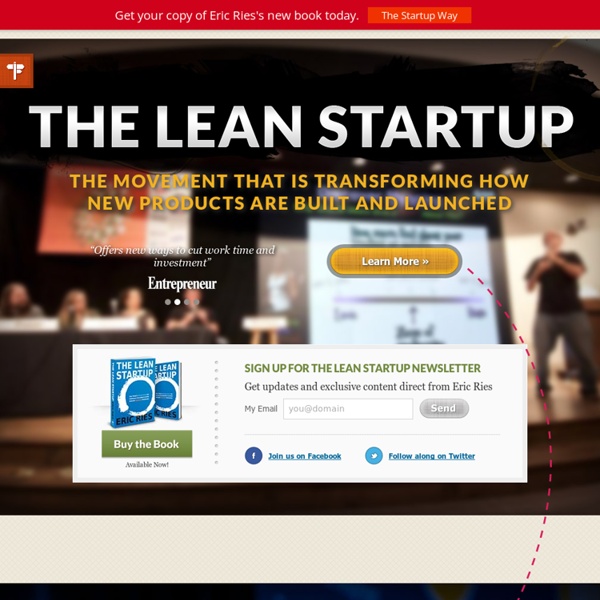



The Internet of Things Is Changing How We Manage Customer Relationships Steven Moore Just as it’s hard to remember what life was like before the iPhone, it can be hard to remember business before there was CRM software — back when you still had to explain that it stood for “customer relationship management.” Today, CRM pervades the way many companies track and measure how they interact with other organizations, across many departments: marketing, sales, customer service, support, and others. CRM made it possible to determine precisely who responded to a specific marketing campaign and then who became a paying customer, which customer called the most for support, and so on. It gave companies some overall measure of revenue compared with marketing spend — something described in this 2007 article in The New York Times.
Blog « Categories « Lean Startup Machine What is Lean Startup? “Lean Startup” is a term coined by Eric Ries while an Advisor to the venture capital firm Kleiner Perkins. It’s based on the new management processes he employed while Chief Technology Officer at IMVU, one of Silicon Valley’s most successful startups. What is Customer Development? “Customer Development” is a process pioneered by Steve Blank and written about extensively in Four Steps to the Epiphany.
O'Reilly Media - Tech Books, DRM-Free Ebooks, Videos The high points in this book from Jeff Patton are too numerous to mention. I found myself taking copious notes, and you could do the same, but it would probably make more sense to keep it near you and dip into it regularly until you have fully digested it. It is filled with good quotes e.g. 'There's always more to build than you have people, time, or money for. Splitting User Stories - Agile For All Working from a prioritized backlog of small user stories allows a team to get value and high-quality feedback on frequent intervals. Many teams struggle to split large user stories into small stories in a useful way. Instead of ending up with small vertical slices through their architecture, they get stories that look more like tasks or architectural components and fail to experience the value or feedback small stories should provide. Fortunately, story splitting is a skill that can be learned in a relatively short time. I’ve seen teams go from struggling to fluently splitting stories with just a couple hours of practice and some simple tools.
Human factors and ergonomics Human factors and ergonomics (HF&E), also known as comfort design, functional design, and user-friendly systems,[1] is the practice of designing products, systems or processes to take proper account of the interaction between them and the people who use them. The field has seen contributions from numerous disciplines, such as psychology, engineering, biomechanics, industrial design, physiology and anthropometry. In essence, it is the study of designing equipment and devices that fit the human body and its cognitive abilities.
The Art of Bootstrapping Someone once told me that the probability of an entrepreneur getting venture capital is the same as getting struck by lightning while standing at the bottom of a swimming pool on a sunny day. This may be too optimistic. Let's say that you can't raise money for whatever reason: You're not a “proven” team with “proven” technology in a “proven” market. Or, your company may simply not be a “VC deal”--that is, something that will go public or be acquired for a zillion dollars. Finally, your organization may be a not-for-product with a cause like the ministry or the environment. Does this mean you should give up?
Disciplined Learning Dr. Alistair CockurnHumans and Technology Technical Report TR-2013.01 Feb. 2013, ©2013 Alistair Cockburn alias: Learn Early, Learn Often alias: DAKA2 (and see also DAKA) Communities From the Policy Diaogue on Entrepreneurship to Entrepreneurship Law, the ID8 Nation and eMed, we have the right Community for you. Join a community today! 1 Million Cups (1MC) is a simple way to engage entrepreneurs in communities around the world.
Dual-Track Scrum Posted by marty cagan on September 17, 2012 Tags: scrum, agile, product discovery When I first start working with an Agile product team, one of the most common situations I find is where the teams have long and frustrating Sprint planning meetings because backlog items are poorly defined and not well understood; they have slow velocity as well as poor design because details are still being worked out during the Sprint; and the amount of waste and rework is very high because backlog items have not been validated. Remember that our higher order objective is to validate our ideas the fastest, cheapest way possible. Actually building and launching a product idea is generally the slowest, most expensive way to validate the idea.
"Eric Ries (born 1979) is a Silicon Valley entrepreneur and author recognized for pioneering the Lean Startup movement, a new-business strategy which directs startup companies to allocate their resources as efficiently as possible. He is also a well-known blogger within the technology entrepreneur community." by primpact Mar 30